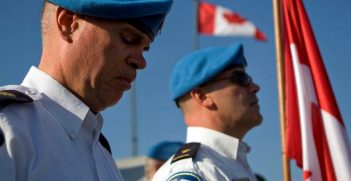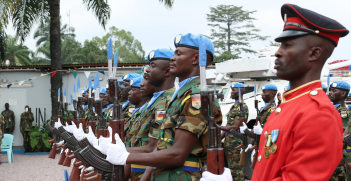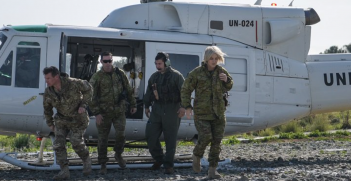Privatised peacekeeping and the UN

Contractors have played invaluable roles in UN operations over the past 30 years. Despite this, private operators continue to occupy a grey area between combatant and civilian and their exact legal status remains uncertain.
Peacekeeping is arguably the United Nations’ most visible contribution to international peace and security; UN peacekeeping operations (PKOs) provide indispensable support to conflict-ridden communities. However the UN faces a number of serious challenges in securing, training and deploying a peacekeeping force. As detailed in the 2000 Report of the Panel on United Nations Peace Operations:
“The troops that eventually arrive in theatre may still be under equipped: Some countries have provided soldiers without rifles, or with rifles but no helmets, or with helmets but no flak jackets, or with no organic transport capability (trucks or troops carriers). Troops may be untrained in peacekeeping operations, and in any case the various contingents in an operation are unlikely to have trained or worked together before. Some units may have no personnel who can speak the mission language. Even if language is not a problem, they… may have differing expectation about mission requirements for the use of force.”
Private military and security companies (PMSCs) provide an enticing solution to some of these problems.
The UN has regularly used PMSCs in its operations since the 1990s. They perform tasks such as protecting personnel, logistical support, intelligence training, peacekeeper training, maintenance, demining and ordnance disposal. Despite the extent of support that PMSCs provide, little information about the formal arrangements between the UN and these groups is available to the general public.
Usually, PMSCs directly engaged by the UN are restricted to non-military functions. In some cases, a member state or third party to the UN seconds PMSC personnel as part of troop contributions. In both scenarios, there is a potential for PMSC contractors—alongside peacekeepers generally—to become involved in armed exchanges to defend themselves, civilians or the mission generally.
The use of force by the private contractors in such scenarios could foreseeably lead to violations of humanitarian or human rights norms. This is one of the central reasons why the inclusion of PMSC personnel in UN PKOs is controversial. Important questions arise about when PMSCs in PKOs can legitimately use armed force, what legal norms govern their conduct, and how they can be held accountable for any violations.
The branch of international law that governs the conduct of armed conflict, international humanitarian law (IHL), is well placed to answer these questions. However, holding contractors accountable under IHL poses a number of challenges. One problem is that personnel in UN PKOs typically enjoy wide immunities from international and domestic legal processes. This potentially extends to PMSCs. A second challenge is that the categorisation of PMSCs in UN operations under IHL remains disputed. The context for this issue is provided by the sharp distinction under IHL between combatants and civilians. The principle of distinction—a central tenet of IHL—requires combatants to distinguish at all times between military targets and civilian objects and stipulates that only military targets may be the object of attack.
Article 43(2) of Additional Protocol I to the Geneva Conventions of 1949 states that combatants “have the right to participate directly in hostilities”. It is sometimes suggested that this means only combatants can participate directly in armed conflict. Civilians, on this view, are prohibited under IHL from using armed force against combatants (unless, perhaps, they do so in self-defence). Call this the prohibitive view of civilian status. The prohibitive view raises difficulties for the status of PMSCs. If PMSCs are combatants, then this view holds that they are permitted to use force against other combatants and military objectives. However, they then also become fair targets for other participants. If PMSCs are civilians, then they are imine from direct attack. However, the prohibitive view then holds that they may not exercise force in armed conflict.
How should we view PMSCs?
There is strong international support—as well as good reasons—for generally characterising UN peacekeepers as civilians, rather than combatants. The UN Secretary-General’s 1999 Bulletin on Observance by United Nations Forces of IHL provides that peacekeepers are “non-combatants, as long as they are entitled to the protections given to civilians under the international law of armed conflict.” An important advantage of recognising the civilian status of UN peacekeepers is that it protects them from direct attack. Peacekeepers, on this view, are akin to humanitarian workers. They are not there to participate directly in hostilities, so other parties should not engage them militarily.
A potential problem, however, is that UN peacekeepers are permitted to use force in defence of the mission mandate. The prohibitive view of civilian status holds that civilians who directly participate in armed exchanges violate international law, suggesting that UN peacekeepers that use force, even in defence of their mandate, may thereby contravene IHL. This leaves peacekeepers in a tenuous and ambiguous position. For example, a peacekeeper entrusted with the protection of UN officials, premises or vulnerable civilians could quickly become embroiled in an armed exchange with combatants. It seems odd to say that a civilian peacekeeper that fires on combatants in pursuit of the peacekeeping mandate thereby commits a violation of international law.
We suggest that abandoning the prohibitive view offers a solution to this problem. It is a mistake, in our view, to interpret Article 43(2) of Additional Protocol I as prohibiting non-combatants from participating in hostilities. There is, after all, no provision in the Geneva Conventions or Additional Protocols expressly stating such a prohibition. Other provisions that deal with civilians who engage directly in hostilities merely state that they lose their immunity from attack while doing so.
PMSC personnel in UN PKOs, on this view, are best viewed as non-combatants, who may, in some circumstances, participate directly in armed conflict (and do not necessarily violate IHL by doing so). They are not culpable under international law for the use of force against combatants, as long as they comply with the principles of IHL They may not, for example, use indiscriminate or prohibited weapons, or target civilians. They are classified as non-combatants, so they enjoy a general immunity from attack. However, if they take up arms and engage directly in hostilities, they can lawfully be targeted by opposing forces for the duration of their involvement.
Private contractors in UN peacekeeping operations, then, do not occupy a legal vacuum by falling outside the existing categories of persons under IHL. This, of course, does not resolve the question of how they can effectively be held accountable for violations. The most promising path to accountability, we suggest, lies in the current trend towards a unified law of armed conflict that encompasses not only IHL proper, but also aspects of international human rights law, international criminal law and the law governing the use of force. The overlap of IHL with human rights and criminal standards, in particular, offers significant resources for holding PMSCs to account. A legal and political discourse that emphasises these overlaps holds the potential to help overcome perceptions that PMSCs operate in a legal vacuum and to reveal the full range of legal mechanisms available.
Jonathan Crowe is Professor of Law at Bond University and the president of the Australasian Society of Legal Philosophy.
Anna John holds degrees in law and international relations from the University of Queensland. She will be commencing an LLM in public international law in late 2017 at Leiden University, the Netherlands.
This article is published under a Creative Commons License and may be republished with attribution.





